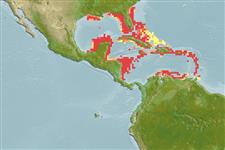>
Clupeiformes (Herrings) >
Engraulidae (Anchovies) > Engraulinae
Etymology: Anchoviella: Italian ancioa = anchovy (Ref. 45335).
Eponymy: Professor Felipe Poey y Aloy (1799–1891) was a Cuban zoologist, naturalist and artist. [...] (Ref. 128868), visit book page.
More on author: Poey.
Environment: milieu / climate zone / intervalo de profundidade / distribution range
Ecologia
marinhas pelagic-neritic; intervalo de profundidade 0 - 50 m (Ref. 189). Tropical; 32°N - 10°N, 94°W - 60°W (Ref. 189)
Western Central Atlantic: Beaufort, North Carolina south to Florida (USA); Antilles from Cuba to St. Lucia, also Trinidad, but not recorded at Blanquilla and Los Roques off Venezuela; also occurs off Panama.
Tamanho / Peso / Idade
Maturidade: Lm ? range ? - ? cm
Max length : 11.0 cm TL macho/indeterminado; (Ref. 5217); common length : 9.0 cm TL macho/indeterminado; (Ref. 5217)
Espinhos dorsais (total) : 0; Raios dorsais moles (total) : 15 - 16; Espinhos anais: 0; Raios anais moles: 10 - 18. Body slightly compressed; snout moderate, about 3/4 eye diameter; maxilla short with bluntly rounded tip, failing to reach pre-operculum by 1/2 pupil diameter; pseudobranch short, about 3/4 eye diameter; panamensis-type gill cover canals. Anal fin origin slightly behind base of last dorsal fin ray. A bright silver stripe along flank, about 3/4 or almost equal to eye, dark bordered above (Ref. 189). Body pale, few melanophores above, row of anal melanophores along anal-fin base. Eye orangish above, top of head with green and gold reflections (Ref. 7251).
Body shape (shape guide): elongated; Cross section: oval.
Occurs in coastal waters, apparently not entering brackish water. Rare in Florida shore seine collections, but 'in great numbers under a night light', perhaps because it may stay some distance from the shore in daytime.
Life cycle and mating behavior
Maturidade | Reprodução | Desova | Ovos | Fecundidade | Larvas
Spawn in school (Ref. 205).
Whitehead, P.J.P., G.J. Nelson and T. Wongratana, 1988. FAO Species Catalogue. Vol. 7. Clupeoid fishes of the world (Suborder Clupeoidei). An annotated and illustrated catalogue of the herrings, sardines, pilchards, sprats, shads, anchovies and wolf-herrings. FAO Fish. Synop. 125(7/2):305-579. Rome: FAO. (Ref. 189)
Categoria na Lista Vermelha da IUCN (Ref. 130435: Version 2025-1)
Ameaça para o homem
Harmless
Utilização humana
Pescarias: pescarias de subsistência; isco: usually
Ferramentas
Relatórios especiais
Descarregue XML
Fontes da internet
Estimates based on models
Preferred temperature (Ref.
123201): 23.4 - 28, mean 26.4 °C (based on 226 cells).
Phylogenetic diversity index (Ref.
82804): PD
50 = 0.5000 [Uniqueness, from 0.5 = low to 2.0 = high].
Bayesian length-weight: a=0.00525 (0.00250 - 0.01100), b=3.13 (2.95 - 3.31), in cm total length, based on LWR estimates for this (Sub)family-body shape (Ref.
93245).
Nível Trófico (Ref.
69278): 3.2 ±0.4 se; based on size and trophs of closest relatives
Resiliência (Ref.
120179): Elevada, tempo mínimo de duplicação da população menor que 15 meses (Preliminary K or Fecundity.).
Fishing Vulnerability (Ref.
59153): Low vulnerability (10 of 100).
🛈
